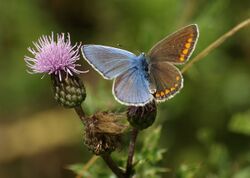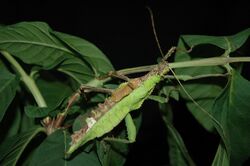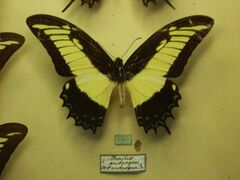Biology:Gynandromorphism


A gynandromorph is an organism that contains both male and female characteristics. The term comes from the Greek γυνή (gynē) 'female', ἀνήρ (anēr) 'male', and μορφή (morphē) 'form', and is used mainly in the field of entomology. Gynandromorphism is most frequently recognized in organisms that have strong sexual dimorphism such as certain butterflies, spiders, and birds, but has been recognized in numerous other types of organisms.
Occurrence
Gynandromorphism has been noted in Lepidoptera (butterflies and moths) since the 1700s.[1][2][3] It has also been observed in crustaceans, such as lobsters and crabs, in spiders,[4] ticks,[5] flies,[6] locusts,[7] crickets,[8] dragonflies,[9] ants,[10][11] termites,[12] bees,[13] lizards,[14] snakes,[15] rodents,[16][17] and birds.[18][19][20][21][22] It is generally rare but reporting depends on ease of detecting it (whether a species is strongly sexually dimorphic) and how well-studied a region or organism is. For example, up until 2023 gynandromorphism had been reported in more than 40 bird species, but the vast majority of these are from the Palearctic and Nearctic, indicating that it likely is underreported in parts of the world that are not as biologically well-studied.[23]
Pattern of distribution of male and female tissues in a single organism
A gynandromorph can have bilateral symmetry—one side female and one side male.[24] Alternatively, the distribution of male and female tissue can be more haphazard. Bilateral gynandromorphy arises very early in development, typically when the organism has between 8 and 64 cells.[25] Later stages produce a more random pattern.[citation needed]
A notable example in birds is the zebra finch. These birds have lateralised brain structures in the face of a common steroid signal, providing strong evidence for a non-hormonal primary sex mechanism regulating brain differentiation.[26]
Normal female of Papilio androgeus
Causes
The cause of this phenomenon is typically (but not always) an event in mitosis during early development. While the organism contains only a few cells, one of the dividing cells does not split its sex chromosomes typically. This leads to one of the two cells having sex chromosomes that cause male development and the other cell having chromosomes that cause female development. For example, an XY cell undergoing mitosis duplicates its chromosomes, becoming XXYY. Usually this cell would divide into two XY cells, but in rare occasions the cell may divide into an X cell and an XYY cell. If this happens early in development, then a large portion of the cells are X and a large portion are XYY. Since X and XYY dictate different sexes, the organism has tissue that is female and tissue that is male.[27]
A developmental network theory of how gynandromorphs develop from a single cell based on a working paper links between parental allelic chromosomes was proposed in 2012.[28] The major types of gynandromorphs, bilateral, polar and oblique are computationally modeled. Many other possible gynandromorph combinations are computationally modeled, including predicted morphologies yet to be discovered. The article relates gynandromorph developmental control networks to how species may form. The models are based on a computational model of bilateral symmetry.[29]
As a research tool
Gynandromorphs occasionally afford a powerful tool in genetic, developmental, and behavioral analyses. In Drosophila melanogaster, for instance, they provided evidence that male courtship behavior originates in the brain,[30] that males can distinguish conspecific females from males by the scent or some other characteristic of the posterior, dorsal, integument of females,[31][32] that the germ cells originate in the posterior-most region of the blastoderm,[33] and that somatic components of the gonads originate in the mesodermal region of the fourth and fifth abdominal segment.[34]
See also
- Androgyny
- Chimerism
- Gynomorph
- Half-sider budgerigar
- Hermaphrodite
- Intersex in humans
- Intersex in other species
References
- ↑ Rudolphi, Karl Asmund (1828). "Beschreibung einer seltenen menschlichen Zwitterbildung nebst vorangeschickten allgemeinen Bemerkungen über Zwitter-Thiere" (in de). Abhandlungen der Königlichen Akademie der Wissenschaften zu Berlin: 45–69. https://books.google.com/books?id=2WFDAQAAMAAJ&pg=PA45.
- ↑ Packard, Alpheus Spring (1875). "On Gynandromorphism in the Lepidoptera". Memoirs Read Before the Boston Society of Natural History 2: 409–412. https://archive.org/details/memoirsreadbefor02bost/page/n443/mode/2up.
- ↑ Pavid, Katie. "Beauty of the dual-gender butterfly". Natural History Museum. https://www.nhm.ac.uk/discover/beauty-dual-gender-butterfly.html.
- ↑ Suzuki, Yuya; Kuramitsu, Kazumu; Yokoi, Tomoyuki (2019-06-14). "Morphology and sex-specific behavior of a gynandromorphic Myrmarachne formicaria (Araneae: Salticidae) spider" (in en). The Science of Nature 106 (7): 34. doi:10.1007/s00114-019-1625-x. ISSN 1432-1904. PMID 31201570. Bibcode: 2019SciNa.106...34S. https://tsukuba.repo.nii.ac.jp/?action=repository_uri&item_id=53830.
- ↑ Labruna, M. B.; Ribeiro, A. F.; Cruz, M. V.; Camargo, L. M A.; Camargo, E. P. (August 2002). "Gynandromorphism in Amblyomma cajennense and Rhipicephalus sanguineus (Acari: Ixodidae)". Journal of Parasitology 88 (4): 810–811. doi:10.1645/0022-3395(2002)088[0810:GIACAR2.0.CO;2]. PMID 12197141.
- ↑ Morgan, T. H. (1 June 1914). "Mosaics and gynandromorphs in Drosophila". Experimental Biology and Medicine 11 (6): 171–172. doi:10.3181/00379727-11-105.
- ↑ Maeno, Koutaro; Tanaka, Seiji (September 2007). "Morphological and behavioural characteristics of a gynandromorph of the desert locust, Schistocerca gregaria". Physiological Entomology 32 (3): 294–299. doi:10.1111/j.1365-3032.2007.00573.x.
- ↑ Taniyama, Katsuya; Onodera, Kaori; Tanaka, Kazuhiro (December 2018). "Sexual identity and sexual attractiveness of a gynandromorph of the lawn ground cricket, Polionemobius mikado (Orthoptera: Trigonidiidae): Gynandromorph of Polionemobius mikado". Entomological Science 21 (4): 423–427. doi:10.1111/ens.12321.
- ↑ Renjith, R. V.; Chandran, A. Vivek (26 June 2020). "A record of gynandromorphism in the libellulid dragonfly Crocothemis servilia (Insecta: Odonata) from India". Journal of Threatened Taxa 12 (9): 16183–16186. doi:10.11609/jott.5322.12.9.16183-16186.
- ↑ Donisthorpe, Horace (1929). "Gynandromorphism in ants". Zoologischer Anzeiger 82: 92–96. http://antbase.org/ants/publications/5762/5762.pdf.
- ↑ Cokendolpher, James C.; Francke, Oscar F. (1983). "Gynandromorphic Desert Fire Ant, Solenopsis aurea Wheeler (Hymenoptera: Formicidae)". Journal of the New York Entomological Society 91 (3): 242–245. ISSN 0028-7199. https://www.jstor.org/stable/25009362.
- ↑ Miyaguni, Yasushi; Nozaki, Tomonari; Yashiro, Toshihisa (August 2017). "The first report of gynandromorphy in termites (Isoptera; Kalotermitidae; Neotermes koshunensis)". The Science of Nature 104 (7–8): 60. doi:10.1007/s00114-017-1478-0. PMID 28676938. Bibcode: 2017SciNa.104...60M.
- ↑ Lucia, Mariano; Gonzalez, Victor. H. (1 November 2013). "A New Gynandromorph of Xylocopa frontalis with a Review of Gynandromorphism in Xylocopa (Hymenoptera: Apidae: Xylocopini)". Annals of the Entomological Society of America 106 (6): 853–856. doi:10.1603/AN13085.
- ↑ Mitchell, Joseph C.; Fouquette, M. J. (10 February 1978). "A Gynandromorphic Whiptail Lizard, Cnemidophorus inornatus, from Arizona". Copeia 1978 (1): 156. doi:10.2307/1443840.
- ↑ Krohmer, Randolph W. (27 December 1989). "Reproductive Physiology and Behavior of a Gynandromorph Redsided Garter Snake, Thamnophis sirtalis parietalis, from Central Manitoba, Canada". Copeia 1989 (4): 1064–1068. doi:10.2307/1446001.
- ↑ Asdell, S. A. (1942). "The Accessory Reproductive Tract in Mammalian True Hermaphrodites, an Effect of Position". The American Naturalist 76 (762): 75–84. doi:10.1086/281015. ISSN 0003-0147. https://www.jstor.org/stable/2457667.
- ↑ Hollander, W. F.; Gowen, John W.; Stadler, Janice (February 1956). "A study of 25 gynandromorphic mice of the Bagg albino strain". The Anatomical Record 124 (2): 223–243. doi:10.1002/ar.1091240207. PMID 13302819.
- ↑ Chen, Xuqi; Agate, Robert J.; Itoh, Yuichiro; Arnold, Arthur P. (2005). "Sexually dimorphic expression of trkB, a Z-linked gene, in early posthatch zebra finch brain". Proceedings of the National Academy of Sciences 102 (21): 7730–5. doi:10.1073/pnas.0408350102. PMID 15894627. Bibcode: 2005PNAS..102.7730C.
- Laura Wright (March 25, 2003). "Unique Bird Sheds Light on Sex Differences in the Brain". Scientific American. http://www.scientificamerican.com/article.cfm?id=unique-bird-sheds-light-o.
- ↑ Gouldian finch Erythrura gouldiae Gynandromorph
- ↑ Powdermill Banding Fall 2004
- ↑ A Gender-bender Colored Cardinal, by Tim Wall, Discovery News, 31 May 2011 [1]
- ↑ "Half-cock chicken mystery solved". BBC News. 11 March 2010. http://news.bbc.co.uk/2/hi/uk_news/scotland/edinburgh_and_east/8561814.stm.
- ↑ Stępniewski, J.; Surmacki, A. (2023). "The first case of bilateral gynandromorphic plumage type in the bearded reedling Panurus biarmicus". The European Zoological Journal 90 (2): 643-647. doi:10.1080/24750263.2023.2231000.
- ↑ Ian Sample, science correspondent (12 July 2011). "Half male, half female butterfly steals the show at Natural History Museum". The Guardian (London). https://www.theguardian.com/science/2011/jul/12/half-male-half-female-butterfly.
- ↑ Malmquist, David (June 15, 2005). "Rare crab may hold genetic secrets". Virginia Institute of Marine Science. http://www.vims.edu/newsandevents/topstories/archives/2005/dual_sex_crab.php.
- ↑ Arnold, Arthur P. (2004). "Sex chromosomes and brain gender". Nature Reviews Neuroscience 5 (9): 701–8. doi:10.1038/nrn1494. PMID 15322528.
- ↑ Adams, James K.. "Gynandromorphs". Department of Natural Sciences, Dalton State College. http://www.daltonstate.edu/galeps/Gynandromorphs.htm.
- ↑ Werner, Eric (2012). "A Developmental Network Theory of Gynandromorphs, Sexual Dimorphism and Species Formation". arXiv:1212.5439 [q-bio.MN].
- ↑ Werner, Eric (2012). "The Origin, Evolution and Development of Bilateral Symmetry in Multicellular Organisms". arXiv:1207.3289 [q-bio.TO].
- ↑ Hotta, Y, and Benzer, S. (1972). "Mapping of Behaviour in Drosophila mosaics". Nature 240 (5383): 527–535. doi:10.1038/240527a0. PMID 4568399. Bibcode: 1972Natur.240..527H.
- ↑ Nissani, M. (1975). "A new behavioral bioassay for an analysis of sexual attraction and pheromones in insects". Journal of Experimental Zoology 192 (2): 271–5. doi:10.1002/jez.1401920217. PMID 805823.
- ↑ Hotta, Y., Benzer, S. (1976). "Courtship in Drosophila mosaics: sex-specific foci for sequential action patterns". Proc Natl Acad Sci U S A 73 (11): 4154–4158. doi:10.1073/pnas.73.11.4154. PMID 825859. Bibcode: 1976PNAS...73.4154H.
- ↑ Nissani, Moti (1977). "Cell lineage analysis of germ cells of Drosophila melanogaster". Nature 265 (5596): 729–731. doi:10.1038/265729a0. PMID 404558. Bibcode: 1977Natur.265..729N.
- ↑ Szabad, Janos, and Nothiger, Rolf (1992). "Gynandromorphs of Drosophila suggest one common primordium for the somatic cells of the female and male gonads in the region of abdominal segments 4 and 5". Development 115 (2): 527–533. doi:10.1242/dev.115.2.527. PMID 1425338. http://dev.biologists.org/content/develop/115/2/527.full.pdf.
External links
- "Stunning Dual-Sex Animals" at Live Science
- Aayushi Pratap: This rare bird is male on one side and female on the other; on: Sciencenews; October 6, 2020; about a gynandromorph rose-breasted grosbeak.
 |






